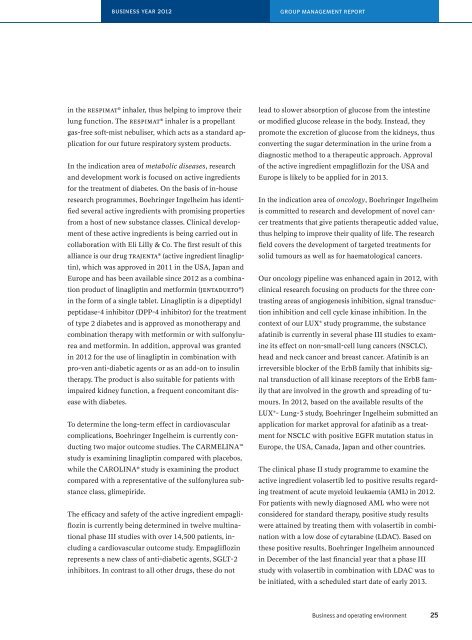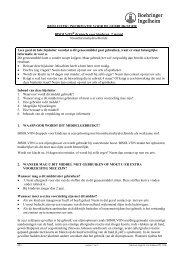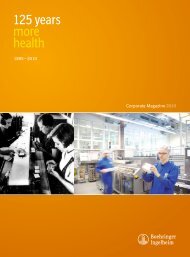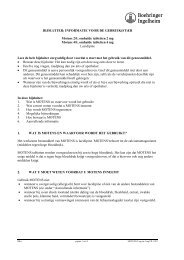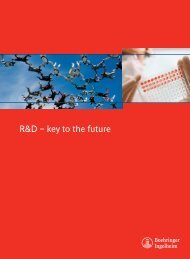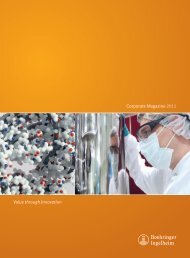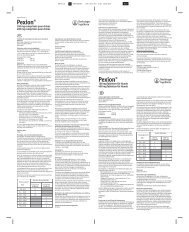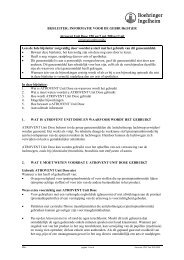Corporate Magazine 2012 - Boehringer Ingelheim
Corporate Magazine 2012 - Boehringer Ingelheim
Corporate Magazine 2012 - Boehringer Ingelheim
Create successful ePaper yourself
Turn your PDF publications into a flip-book with our unique Google optimized e-Paper software.
usiness year <strong>2012</strong>group management reportin the respimat® inhaler, thus helping to improve theirlung function. The respimat® inhaler is a propellantgas-free soft-mist nebuliser, which acts as a standard applicationfor our future respiratory system products.In the indication area of metabolic diseases, researchand development work is focused on active ingredientsfor the treatment of diabetes. On the basis of in-houseresearch programmes, <strong>Boehringer</strong> <strong>Ingelheim</strong> has identifiedseveral active ingredients with promising propertiesfrom a host of new substance classes. Clinical developmentof these active ingredients is being carried out incollaboration with Eli Lilly & Co. The first result of thisalliance is our drug trajenta® (active ingredient linagliptin),which was approved in 2011 in the USA, Japan andEurope and has been available since <strong>2012</strong> as a combinationproduct of linagliptin and metformin (jentadueto®)in the form of a single tablet. Linagliptin is a dipeptidylpeptidase-4 inhibitor (DPP-4 inhibitor) for the treatmentof type 2 diabetes and is approved as monotherapy andcombination therapy with metformin or with sulfonylureaand metformin. In addition, approval was grantedin <strong>2012</strong> for the use of linagliptin in combination withpro-ven anti-diabetic agents or as an add-on to insulintherapy. The product is also suitable for patients withimpaired kidney function, a frequent concomitant diseasewith diabetes.To determine the long-term effect in cardiovascularcomplications, <strong>Boehringer</strong> <strong>Ingelheim</strong> is currently conductingtwo major outcome studies. The CARMELINAstudy is examining linagliptin compared with placebos,while the CAROLINA® study is examining the productcompared with a representative of the sulfonylurea substanceclass, glimepiride.The efficacy and safety of the active ingredient empagliflozinis currently being determined in twelve multinationalphase III studies with over 14,500 patients, includinga cardiovascular outcome study. Empagliflozinrepresents a new class of anti-diabetic agents, SGLT-2inhibitors. In contrast to all other drugs, these do notlead to slower absorption of glucose from the intestineor modified glucose release in the body. Instead, theypromote the excretion of glucose from the kidneys, thusconverting the sugar determination in the urine from adiagnostic method to a therapeutic approach. Approvalof the active ingredient empagliflozin for the USA andEurope is likely to be applied for in 2013.In the indication area of oncology, <strong>Boehringer</strong> <strong>Ingelheim</strong>is committed to research and development of novel cancertreatments that give patients therapeutic added value,thus helping to improve their quality of life. The researchfield covers the development of targeted treatments forsolid tumours as well as for haematological cancers.Our oncology pipeline was enhanced again in <strong>2012</strong>, withclinical research focusing on products for the three contrastingareas of angiogenesis inhibition, signal transductioninhibition and cell cycle kinase inhibition. In thecontext of our LUX® study programme, the substanceafatinib is currently in several phase III studies to examineits effect on non-small-cell lung cancers (NSCLC),head and neck cancer and breast cancer. Afatinib is anirreversible blocker of the ErbB family that inhibits signaltransduction of all kinase receptors of the ErbB familythat are involved in the growth and spreading of tumours.In <strong>2012</strong>, based on the available results of theLUX®- Lung-3 study, <strong>Boehringer</strong> <strong>Ingelheim</strong> submitted anapplication for market approval for afatinib as a treatmentfor NSCLC with positive EGFR mutation status inEurope, the USA, Canada, Japan and other countries.The clinical phase II study programme to examine theactive ingredient volasertib led to positive results regardingtreatment of acute myeloid leukaemia (AML) in <strong>2012</strong>.For patients with newly diagnosed AML who were notconsidered for standard therapy, positive study resultswere attained by treating them with volasertib in combinationwith a low dose of cytarabine (LDAC). Based onthese positive results, <strong>Boehringer</strong> <strong>Ingelheim</strong> announcedin December of the last financial year that a phase IIIstudy with volasertib in combination with LDAC was tobe initiated, with a scheduled start date of early 2013.Business and operating environment 25


